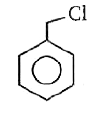Following compounds are given to you :
2-Bromopentane, 2-Bromo-2-methylbutane, 1-Bromopentane
(i) Write the compound which is most reactive towards SN2 reaction
(ii) Write the compound which is optically active
(iii) Write the compound which is most reactive towards β-elimination reaction
To solve the question, we need to analyze the three given compounds: 2-Bromopentane, 2-Bromo-2-methylbutane, and 1-Bromopentane. We will address each part of the question step by step.
Step 1: Identify the Compounds
1. 2-Bromopentane: This compound has a bromine atom attached to the second carbon of a pentane chain.
2. 2-Bromo-2-methylbutane: This compound has a bromine atom attached to the second carbon of a butane chain, which also has a methyl group on the same carbon.
3. 1-Bromopentane: This compound has a bromine atom attached to the first carbon of a pentane chain.
Step 2: Determine Reactivity Towards SN2 Reaction
- SN2 Mechanism: This reaction is favored by primary alkyl halides due to less steric hindrance, allowing the nucleophile to attack from the opposite side of the leaving group.
- Analysis:
- 1-Bromopentane is a primary alkyl halide.
- 2-Bromopentane is a secondary alkyl halide.
- 2-Bromo-2-methylbutane is a tertiary alkyl halide.
Conclusion: The compound most reactive towards SN2 reaction is 1-Bromopentane.
Step 3: Determine the Optically Active Compound
- Optical Activity: A compound is optically active if it has a chiral center, meaning it has four different substituents attached to a carbon atom.
- Analysis:
- 1-Bromopentane has no chiral centers.
- 2-Bromopentane has a chiral center at the second carbon (with different groups: Br, CH2CH3, CH3, and H).
- 2-Bromo-2-methylbutane has no chiral centers as the second carbon has two identical methyl groups.
Conclusion: The optically active compound is 2-Bromopentane.
Step 4: Determine Reactivity Towards Beta-Elimination Reaction
- Beta-Elimination Reaction: This reaction is favored by compounds that can form more stable alkenes. Tertiary alkyl halides are generally more reactive due to the stability of the resulting alkene.
- Analysis:
- 1-Bromopentane would form a less stable alkene.
- 2-Bromopentane would form a more stable alkene.
- 2-Bromo-2-methylbutane can form a highly substituted, stable alkene.
Conclusion: The compound most reactive towards beta-elimination reaction is 2-Bromo-2-methylbutane.
Final Answers
(i) 1-Bromopentane (most reactive towards SN2 reaction)
(ii) 2-Bromopentane (optically active)
(iii) 2-Bromo-2-methylbutane (most reactive towards beta-elimination reaction)
1. 2-Bromopentane: This compound has a bromine atom attached to the second carbon of a pentane chain.
2. 2-Bromo-2-methylbutane: This compound has a bromine atom attached to the second carbon of a butane chain, which also has a methyl group on the same carbon.
3. 1-Bromopentane: This compound has a bromine atom attached to the first carbon of a pentane chain.
- SN2 Mechanism: This reaction is favored by primary alkyl halides due to less steric hindrance, allowing the nucleophile to attack from the opposite side of the leaving group.
- Analysis:
- 1-Bromopentane is a primary alkyl halide.
- 2-Bromopentane is a secondary alkyl halide.
- 2-Bromo-2-methylbutane is a tertiary alkyl halide.
Conclusion: The compound most reactive towards SN2 reaction is 1-Bromopentane.
- Optical Activity: A compound is optically active if it has a chiral center, meaning it has four different substituents attached to a carbon atom.
- Analysis:
- 1-Bromopentane has no chiral centers.
- 2-Bromopentane has a chiral center at the second carbon (with different groups: Br, CH2CH3, CH3, and H).
- 2-Bromo-2-methylbutane has no chiral centers as the second carbon has two identical methyl groups.
- Beta-Elimination Reaction: This reaction is favored by compounds that can form more stable alkenes. Tertiary alkyl halides are generally more reactive due to the stability of the resulting alkene.
- Analysis:
- 1-Bromopentane would form a less stable alkene.
- 2-Bromopentane would form a more stable alkene.
- 2-Bromo-2-methylbutane can form a highly substituted, stable alkene.
(i) 1-Bromopentane (most reactive towards SN2 reaction)
(ii) 2-Bromopentane (optically active)
(iii) 2-Bromo-2-methylbutane (most reactive towards beta-elimination reaction)
Topper's Solved these Questions
- XII BOARDSBOOK - XII BOARD PREVIOUS YEAR PAPER ENGLISHCHAPTER - XII BOARDSEXERCISE - Set II
10 Videos
- XII BOARDSBOOK - XII BOARD PREVIOUS YEAR PAPER ENGLISHCHAPTER - XII BOARDSEXERCISE - Set III
21 Videos
- XII BOARDSBOOK - XII BOARD PREVIOUS YEAR PAPER ENGLISHCHAPTER - XII BOARDSEXERCISE - OUTSIDE DELHI (SET-I)
35 Videos
- SAMPLE PAPER 2019BOOK - XII BOARD PREVIOUS YEAR PAPER ENGLISHCHAPTER - SAMPLE PAPER 2019EXERCISE - SECTION: D
1 Videos
Similar Questions
The following compounds are given to you
2-Bromopentane,2-Bromo-2-methylbutane,1-Bromopentane
(a) Write the compound which is most reactive towards SN2 reaction.
(b) Write the compound which is optically active.
(c). Write the compound which is most reactive towards β-elimination reaction.
View SolutionWhich one is most reactive towards SN1 reactions ?
View Solution
Knowledge Check
Which of the following is most reactive towardSN2 reaction ?
A B
B C
C D
D
Which of the following is most reactive towardSN2 reaction ?
ACH2=CH−CH2−ClBPh−CH2−ClC DPh−C∣∣O−CH2−Cl
DPh−C∣∣O−CH2−Cl
Which one is most reactive towards SN1 reaction?
View SolutionWhich one is the most reactive towards SN1 reaction ?
View SolutionMost reactive halide towards SN1 reactions is
View SolutionWhich one is most reactive towards nucleophilic addition reaction?
View SolutionWhich of the following is least reactive towards SN1?
View SolutionWhich of the given compounds is most reactive towards addition of HCL.
View Solution
